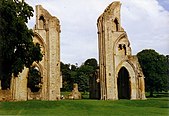Mendip is a local government district covering a largely rural area of 285 square miles (738 km2) ranging from the Mendip Hills through on to the Somerset Levels.
There are 90 Grade I listed buildings in Mendip. Most are Norman- or medieval-era churches, many of which are included in the Somerset towers, a collection of distinctive, mostly spireless Gothic church towers. The greatest concentrations of Grade I listed buildings are in Wells and Glastonbury. In Wells these are clustered around the 10th-century Cathedral Church of St Andrew, better known as Wells Cathedral, and the 13th-century Bishop's Palace. Glastonbury is the site of the Abbey, where construction started in the 7th century, and its associated buildings. The ruined St Michael's church, damaged in an earthquake of 1275, stands on Glastonbury Tor, where the site shows evidence of occupation from Neolithic times and the Dark Ages. The Chalice Well has been in use since Pre-Christian times. Glastonbury Abbey had a wider influence outside the town: tithe barns were built at Pilton and West Bradley to hold tithes, and a Fish House was built at Meare along with a summer residence for the Abbot (now Manor Farmhouse).
Medieval structures include Farleigh Hungerford Castle, and The George Inn at Norton St Philip. Manor houses such as the 15th-century Seymours Court Farmhouse at Beckington and The Old Manor at Croscombe. Mells Manor followed in the 16th century and in the 17th century Southill House in Cranmore was built. Ston Easton Park and Ammerdown House in Kilmersdon were both completed in the 18th century. The most recent buildings included in the list are churches: the Church of St Peter at Hornblotton, and Downside Abbey at Stratton-on-the-Fosse, a Roman Catholic Benedictine monastery and the Senior House of the English Benedictine Congregation. The current buildings were started in the 19th century and are still unfinished. (Full article...)
